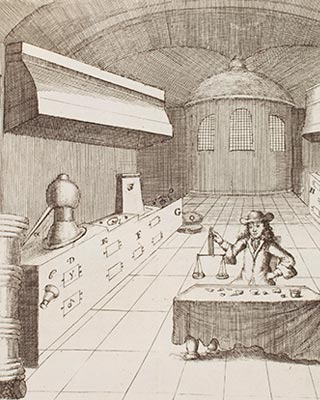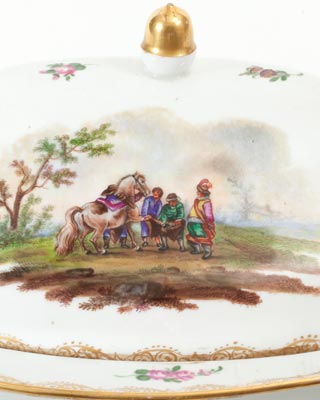During the period in which Barchusen taught the broad significance of chemistry and published his Elementa chemiae, Johann Böttger demonstrated the value of chemistry in the decorative arts. Both men are connected through their common interest in the process of trying to make gold from worthless substances. While Barchusen never produced the legendary philosopher’s stone, referenced recently in the Harry Potter series and thought to be capable of converting base metals into gold, he certainly contributed to alchemical studies. Böttger was imprisoned to make gold after falsely claiming he could. During his imprisonment he applied his chemistry background to clay experimentation resulting in white gold, otherwise known as porcelain

From Alchemy to White Gold

Barchusen's Laboratory, Utrecht
Johann Barchusen, Elementa chemiae, quibus subjuncta est confectura lapidis philosophici imaginibus representata (Leiden: Theodore Haak, 1718)University of Canterbury Library
Johann Barchusen’s Elementa chemiae represents a watershed in the development of modern science; it helps mark the point at which the science of chemistry began to emerge as a discipline in its own right. Barchusen, one of the first dedicated academic chemists and professor of chemistry at Utrecht, in the Netherlands, from 1703, sets out to offer a broad description of his discipline in this book. One of its striking features is the depiction of the transformation of alchemy into chemistry: an appended set of nineteen historical plates represent an alchemical process for turning base metal into gold. The plate shown here illustrates Barchusen in his laboratory surrounded by the tools of his trade. Gifted to the University of Canterbury by an unknown donor, it entered the collection in the 1960s
Meissen porcelain was brought to the market in 1713 as a result of experiments by the chemist Johann Böttger. The recipe was highly treasured and true porcelain, often referred to as white gold, was expensive. The Meissen mark was later added to protect the production of these original coveted ceramics from competing factories. This German porcelain serving dish and cover are thought to be of Meissen manufacture. This is indicated by the crossed sword symbol on the base which is considered one of the oldest trademarks. This particular mark is obscured suggesting that this item may be a factory second or sold undecorated and hand painted later.
Want to know more?
Andy Pratt, 'Barchusen. Elementa Chemiae', in Treasures of the University of Canterbury Library, ed. by Chris Jones & Bronwyn Matthews with Jennifer Clement (Christchurch: CUP, 2011)

Meissen porcelain covered dish, manufactured circa late eighteenth or early nineteenth century.Canterbury Museum, 2001.1.781